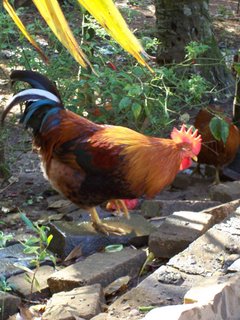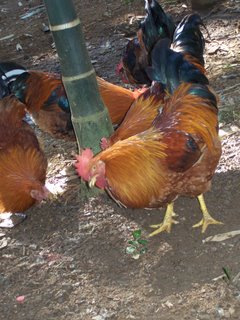
I noticed something at the village of Hainan. The chickens were allowed to run wild! Actually, the word "wild" may not be the most appropriate word to use. The village is fairly secluded by itself and even if the chickens were to run away from their respective owners, there isn't anywhere to run to. Furthermore, I noticed that the families who own a great number of chickens would have dogs who help keep a watch of the chickens.
In addition, I think one good thing about living in this village of Hainan is that everyone knows everyone else in the village, and there is this sense of integrity not to take someone else's chicken without permission. All the chickens that you would see in the photos to come belong to a family that lives nearby my grandmother.
Perhaps because the chickens were allowed to exercise and run about, they did run pretty fast. Initially, whenever I tried to get close to any of the chicken to take a photo of it, the chicken would run away very fast. I suspect that the regular exercises that they had due to being able to run about freely had helped the chickens develop strong leg muscles for running away. As such, I initially had quite a difficult time "chasing after" the chickens to take photographs of them.
One fine day, however, I noticed that the chickens were attracted to the fairly large amount of leftover-food that was discarded at a particular spot near my grandmother's house. Initially, they ran away. After the while, perhaps they realised that I was of no harm, they just simply stayed and enjoyed their feast while I take photographs of them. Then again, were the chickens so afraid that the food may be eaten up by other chickens that they decided that they should eat their fill first than to run away?
Whatever it is, I was glad that I could finally get close enough to the chickens and take photos of them. Initially, I only used non-flash photography. However, when I tried to use flash photography and realised that the chickens weren't afraid of flash, I happily took photographs of the chickens with flash.


The next part of the story that revolves around the chickens is that of identifying whether a chicken is a castrated rooster, a non-castrated rooster or a hen.
I was told by both my aunt and my dad that in that part of the world, the meat from a castrated rooster is regarded as quite a favourite dish. Supposedly, the meat from a castrated rooster has a nice texture and taste to it, compared to the meat from a hen and normal rooster. Yet, perhaps breeding is necessary for the propagation of the chicken breed, non-castrated rooster will continue to exist. So does the hen.
My dad told me that one way to differentiate a castrated rooster from a non-castrated one is to look at its comb. While a castrated rooster has a comb, its comb is usually not as red and big as a non-castrated rooster.
Right below are photos of two respective chickens, try to identify which one is the castrated rooster.


The truth is, I don't really have the answer. However, my dad agreed with me that the chicken in the second photo should be a castrated rooster.
No comments:
Post a Comment